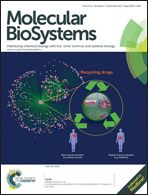Pleiotropic drug-resistance attenuated genomic library improves elucidation of drug mechanisms†
Abstract
Identifying Saccharomyces cerevisiae genome-wide gene deletion mutants that confer hypersensitivity to a xenobiotic aids the elucidation of its mechanism of action (MoA). However, the biological activities of many xenobiotics are masked by the pleiotropic drug resistance (PDR) network which effluxes xenobiotics that are PDR substrates. The PDR network in S. cerevisiae is almost entirely under the control of two functionally homologous transcription factors Pdr1p and Pdr3p. Herein we report the construction of a PDR-attenuated haploid non-essential DMA (PA-DMA), lacking PDR1 and PDR3, which permits the MoA elucidation of xenobiotics that are PDR substrates at low concentrations. The functionality of four key cellular processes commonly activated in response to xenobiotic stress: oxidative stress response, general stress response, unfolded stress response and calcium signalling pathways were assessed in the absence of PDR1 and PDR3 genes and were found to unaltered, therefore, these key chemogenomic signatures are not lost when using the PA-DMA. Efficacy of the PA-DMA was demonstrated using cycloheximide and latrunculin A at low nanomolar concentrations to attain chemical genetic profiles that were more specific to their known main mechanisms. We also found a two-fold increase in the number of compounds that are bioactive in the pdr1Δpdr3Δ compared to the wild type strain in screening the commercially available LOPAC1280 library. The PA-DMA should be particularly applicable to mechanism determination of xenobiotics that have limited availability, such as natural products.


 Please wait while we load your content...
Please wait while we load your content...